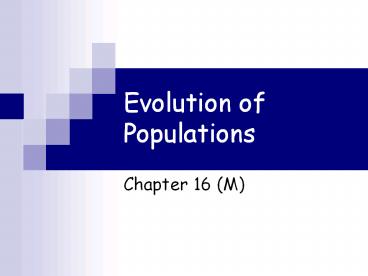Evolution of Populations - PowerPoint PPT Presentation
1 / 41
Title: Evolution of Populations
1
Evolution of Populations
- Chapter 16 (M)
2
- Evolution ? a continuing process of change in a
population of organisms over long periods of time
3
History
- 1700s? Scientists believed that Species are
Fixed and do not change - Mid 1700s? fossil records lead Georges Buffon to
say - Earth is older than 6000years
- Different species arose from variation from a
common ancestor - 1800s? Lamarck explained fossil records species
diversity
4
Lamarck
- Proposed the theory of Inheritance of Acquired
Characteristics? body changes developed during
an organisms life time could be passed on to the
offspring
5
Short neck? ate up grass? had to stretch neckto
reach trees
6
Lamarck
- Acquired characteristics would have to modify DNA
to be inherited? no evidence of this - Lamarcks theory was rejected
- Set the stage for Darwin
7
- Variation in the population? long short necks
- Long necked survived? reproduced? population was
gradually changed to long necked animals
8
Darwin(1809-1882)
- Started his voyages at the age of 22 on the HMS
Beagle - Was responsible for collecting specimens of
fossils - He was aware of geological formations of land
masses? could explain fossils of snails from
mountains - Studied his collections for the next 22 years
9
Darwins Key Observations
- Fossils fossil records show that organisms ?
simpler ? complex - Overproduction of offspring
- Limited supply of resources in an environment
- Survival in a limited environment depends in part
on features inherited from parents
10
Information that influenced Darwin
- Charles Lyell? geologist proposed that the Earth
was very old and had slowly been changing for
millions of years - Thomas Malthus ? economist ? social problems as a
result of the exponential growth of the human
population - Artificial selection by breeders
11
Darwin Concluded
- Descent with Modification
- Natural Selection
12
Descent with Modification
- All present day organisms are related through
descent from unknown ancestors in the past. - These descendants of earliest organisms spread
into different habitats? adapted to diverse ways
of life
13
Natural Selection
- Individuals whose inherited characteristics adapt
them best to their environment are most likely to
survive and reproduce - Basic Mechanism of Evolution? Natural Selection
14
Natural Selection
- Occurs over a vast period of time
- Individuals undergo selection, but do not evolve?
Populations Evolve
15
Evidence of Evolution
- Section 16.4(M)
16
Evidence
- Fossil Records
- Comparative Anatomy
- Embryonic Structures
- DNA Homology
17
Fossils
- Remains, traces or imprints of an organism
preserved in the earths crust - Imprint
- Mold
- Cast
- Petrified
18
Fossil Records
- Fossils the order in which they appear in
layers of rocks - Fossil records show that animals plants have
appeared in a historical sequence, fossils found
in rocks of different ages differ because life on
Earth has changed through time
19
Each Layer represents a particular time period
20
Comparative Anatomy
- The comparison of body structures in different
species - Homologous Structures
- Analogous Structures
- Vestigial Structures
- Ex common descent? evident in anatomical
similarities between species in the same
taxonomic group
21
Homologous Structures
- Structures that are similar have been derived
from a common ancestor, but have been adapted to
different functions. - ex humans, cats, whales, bats? all mammals
- Whales flipper does not have the same function
as a bats wing
22
Homologous Structures
23
Analogous Structures
- Body parts similar in function but have different
structures - Ex wings of insects and birds
24
Vestigial Structures
- Body parts reduced in size appear to serve no
function
25
Embryonic Structures
- Embryos of closely related organisms often have
similar stages in development
26
DNA Homology
- Comparison of genes and proteins shows the
relationships between species
27
Darwins Natural Selection A Mechanism of
Evolution
28
Natural Selection
- Regional and timely
- Adapts organisms to their local environment
- Environmental factors vary from place to place
time to time? adaptation in one situation may be
useless in another - Example Biston betularia? peppered moth
29
Peppered Moth
- England ? two varieties? dark light
- 1850? almost all were light? industrial
revolution? pollution? tree trunks turned black?
light moths became easy prey - Dark survived reproduced
- End of century ? almost all were dark
30
Biston betularia peppered moth
31
Populations
- A group of individuals of the same species living
in the same place at the same time - Mainland animal species colonizes a chain of
distant and isolated islands? separate
population. - These populations adapt to their local
environments. - Over time, the isolated populations would become
more and more different. - And over many generations, the populations could
become different enough to be separate species.
32
Darwins Finches? adapted to different food
sources ?beak Structures
33
Variation
- Differences among members of the same Species
34
(No Transcript)
35
Adaptation
- Inherited trait that Improves the Chances Of
Survival Reproduction - Structural? mimicry? organism copies the
appearance of another species - Physiological? changes in the organisms metabolic
process? penicillin? drug resistant bacteria - Behavioral? inherited behavior pattern that
allows organism to survive
36
Adaptation- Mimicry
- Monarch? tastes bitter? birds avoid them because
they get sick
- Viceroy(extra black lines on wings)? not bitter,
look act like Monarchs ?birds avoid them
37
Adaptation Camouflage
- Protective adaptation that allows an organism to
blend into its surroundings - The better the camouflage, the more likely it is
for the organism to survive and reproduce
38
Adaptation Camouflage
39
Artificial Selection
- Selective breeding of domesticated plants and
animals to produce offspring with genetic traits
that humans value.
40
From Wild Mustard to our Table
41
Pesticides- Natural Selection in Action
- Spraying crops ?kill insect pests? favored the
reproduction of insects with inherited resistance
to the poisons































